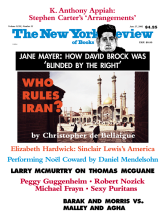To the Editors:
In “The Mystery of Ignazio Silone” [NYR, March 14], William Weaver asserts that the evidence we presented on the “caso Silone”—dozens of reports in which the author of Bread and Wine unveiled the clandestine structure of the Communist Party to the Fascist police—was challenged on the grounds that we misrepresented what we had found and ignored other documents. Reading books like ours is, in Mr. Weaver’s opinion, “an unpleasant experience”; we “line up [our] documents like a card player laying out a game of solitaire.”
We regret that the complexity of the caso Silone should be reduced to a dispute over the authenticity of police documents. Yet the reports show in great detail the when, the how, and the extent of Silone’s collaboration with Fascism. Despite the allegations presented by Tamburrano and his associates (who, incidentally, are no “researchers” but his wife and employee), no archival historian has challenged the accuracy of our study. On the contrary, many (including Ferroni, Melograni, Galli della Loggia, Canfora, etc., of whom Weaver makes no mention) have accepted our findings and called for a more attentive reading of Silone’s literature and a new study of his intellectual biography.
Contrary to Mr. Weaver’s opinion, although we had found a long, handwritten confession addressed by Silone to a high- ranking police official, we subjected all archival documents to checks and counterchecks. As historians, we had to do this before we could even attempt an interpretive analysis of the many other issues involved—political, biographical, etc. To eliminate any possible doubts, Canali has since published the manuscript originals from which the police reports were drafted (Liberal, June 2000). Mrs. Darina Laracy, Silone’s wife, has confirmed their authenticity in an interview with La Repubblica; they are in Silone’s own handwriting.
The true question, then, is why. Why did Silone establish a link to the police and why did it last for over ten years? Some inaccurate statements made by Mr. Weaver do not help matters. It is not true, as he indicates, that in 1928 Silone’s brother was sentenced to death. It is also not true that Silone resorted to his “many internationally famous admirers” to put pressure on Italian authorities and save his brother’s life. At the time Silone was an active member of the Italian Communist Party, he had not written any novels and was unknown to European literary circles. He had no influential “admirers.” And he had been sending reports to the Italian police since 1919.
The caso Silone, then, should be approached with an open mind. Silone’s character, as Mr. Weaver clearly realizes, was affected by the many tragedies of his youth—the trauma of becoming an orphan, financial constraints, solitude, the stubborn hostility of his extended family. Soon afterward, when he joined the ranks of the Socialist Party, the hypnotic vision of revolution clashed with the religious values of his education. Silone also became involved with an intelligent police official known for his investigative skills and integrity. Indeed, in the early years of his life, a bitter and ambiguous world shaped Silone’s moral values. “I am on the edge of the abyss,” he wrote once to Don Luigi Orione, the priest who had rescued him from Pescina dei Marsi after it was struck by an earthquake.
Mr. Weaver may be persuaded that we are “judgmental.” It is not so. We have never lost sight of Silone’s psychological and intellectual regeneration in the 1930s, his dedication to writing, his call for sacrifice, and his search for truth. We have also never ignored the crucial elements that made Fontamara, Bread and Wine, and The Seed Beneath the Snow among the most passionate and thought-provoking novels of twentieth-century Italian literature. We do believe, however, that there is more to Silone’s life than “the story of a humble Christian.” Perhaps a new biography by Dario Biocca, soon to be published by Rizzoli, as well as Canali’s forthcoming book on Ovra, will answer some of the questions posed, albeit reluctantly, by Mr. Weaver.
Dario Biocca
Mauro Canali
William Weaver replies:
First the question of Silone’s brother, Romolo Tranquilli. Let me quote the ample and authoritative chronology in Vol. 1 of the Mondadori “Meridiani” edition of Silone’s works (lxxvii et seqq.): “The initial death sentence was later commuted to twelve years’ imprisonment…. Silone sets out to promote an international campaign on Romolo’s behalf.”
I might also quote Maria Paynter’s study Ignazio Silone: Beyond the Tragic Vision: “To save him [Romolo] from execution Silone solicited and obtained the intervention of the Comité de Défense des Victimes du Fascisme. Its petition, also signed by the Nobel laureate Romain Rolland, did in fact contribute to sparing Romolo from execution…” (p. 14).
As for the documents Biocca and Canali have published, there is a debate about their interpretation, a debate that clearly should have been reported, as it was, in an article on Silone. The two authors’ quarrel, then, is with Giuseppe Tamburrano (whom, I must say, I found convincing).
The authors object to my finding them judgmental. But, in their letter, the reference to Silone’s “regeneration” surely implies judgment (and, I think, condescension).
This Issue
June 27, 2002



